Abstract
OBJECTIVE: To determine the relation between cardiorespiratory fitness, as determined with the Canadian Aerobic Fitness Test (CAFT), and selected risk factors for coronary heart disease (CHD) in a Canadian population. DESIGN: Cross-sectional study. On the basis of age-specific and sex-specific national percentile scores, subjects were classified as being in the low-fitness, moderate-fitness or high-fitness category according to maximum oxygen consumption (VO2 max) predicted from performance on the CAFT. PARTICIPANTS: A total of 4082 male and 1205 female Canadian federal public servants aged 30 to 59 years who participated in a voluntary fitness testing program between 1984 and 1991. OUTCOME MEASURES: Body composition (body mass index, triceps skinfold thickness, sum of four skinfold measurements, predicted percentage of body fat and waist-hip ratio), blood lipid levels (total cholesterol, triglycerides, high-density lipoprotein cholesterol [HDL-C], low-density lipoprotein cholesterol and ratio of total cholesterol to HDL-C) and hemodynamic measurements (heart rate and blood pressure at rest and during exercise and predicted VO2 max). MAIN RESULTS: For both men and women the mean anthropometric measurements, blood lipid levels and blood pressure measurements at rest and after exercise were significantly associated with fitness category (p less than 0.05). CONCLUSIONS: In both men and women a higher level of aerobic fitness, as defined by VO2 max predicted from performance on the CAFT, is associated with a more favourable CHD risk profile. The results support the use of VO2 max predicted from performance on the CAFT as a valid procedure for classifying people according to fitness level.
Full text
PDF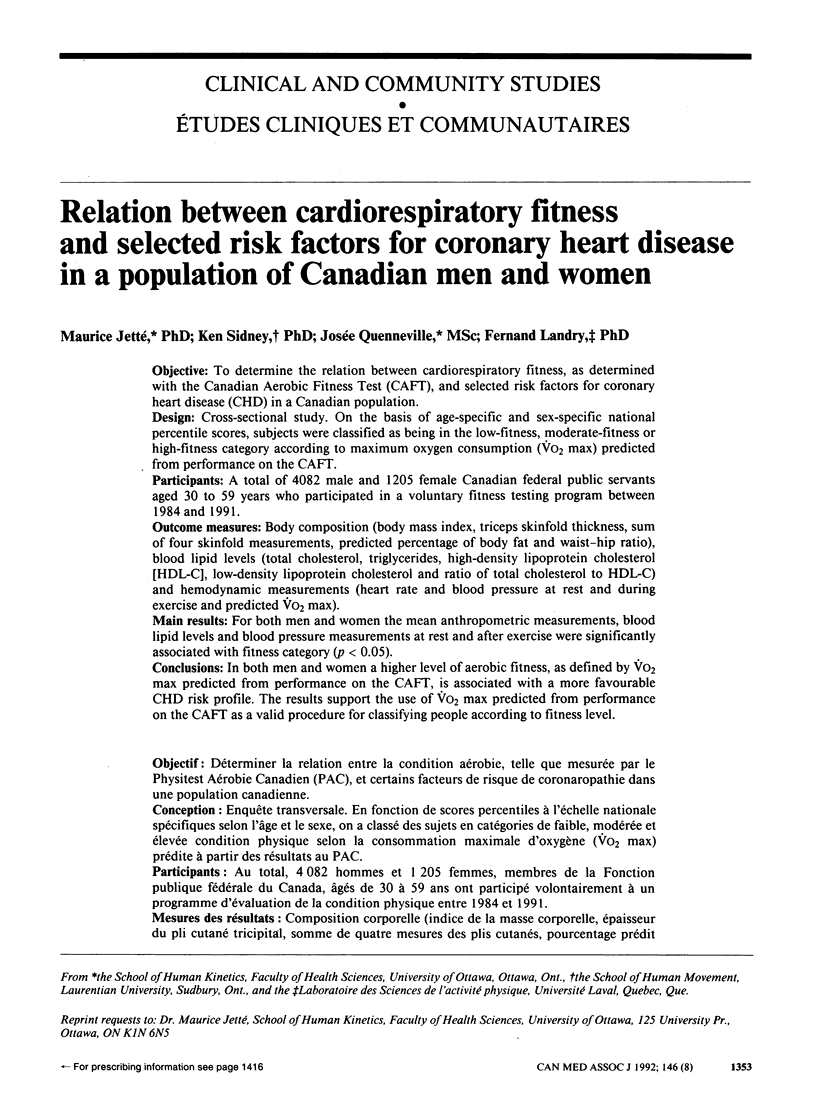
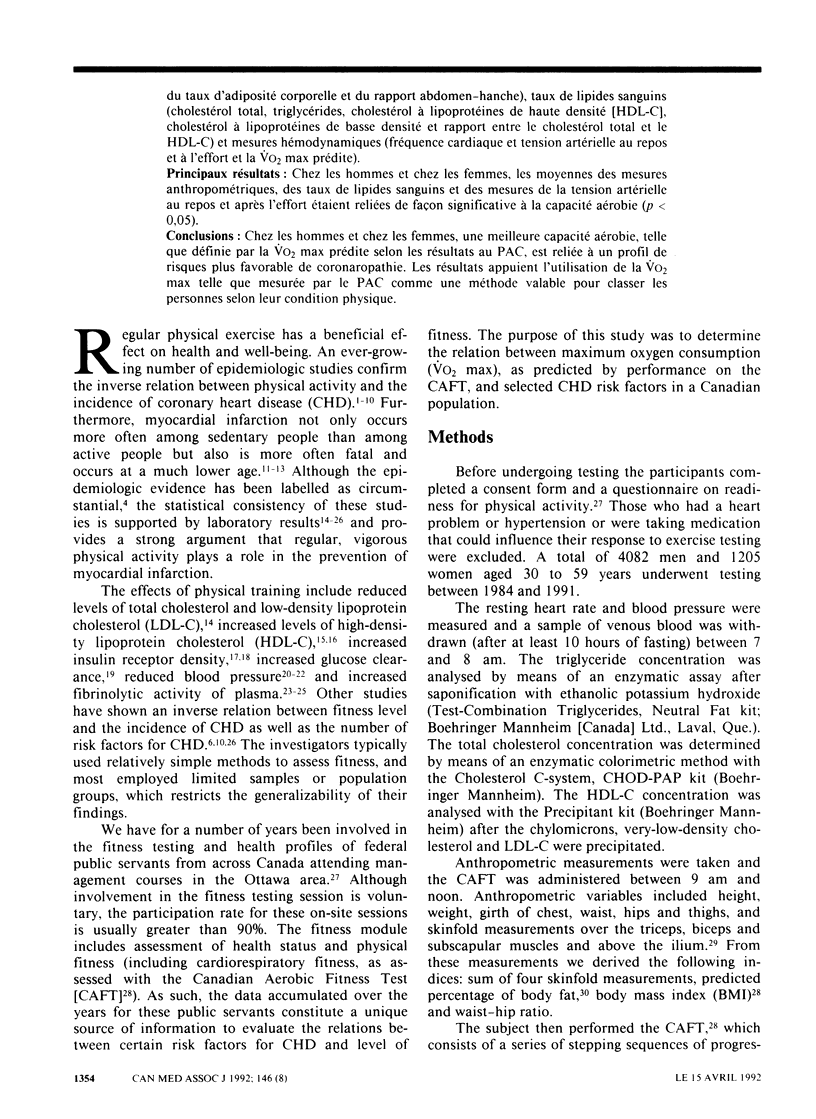
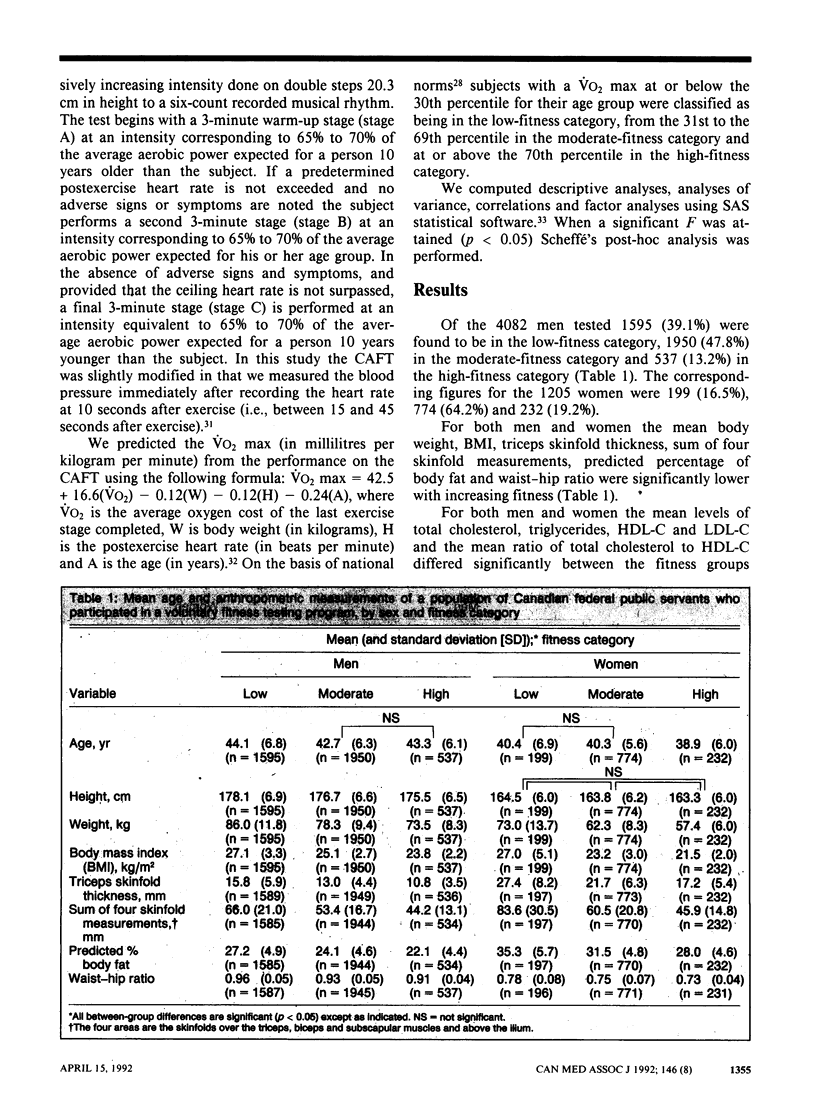
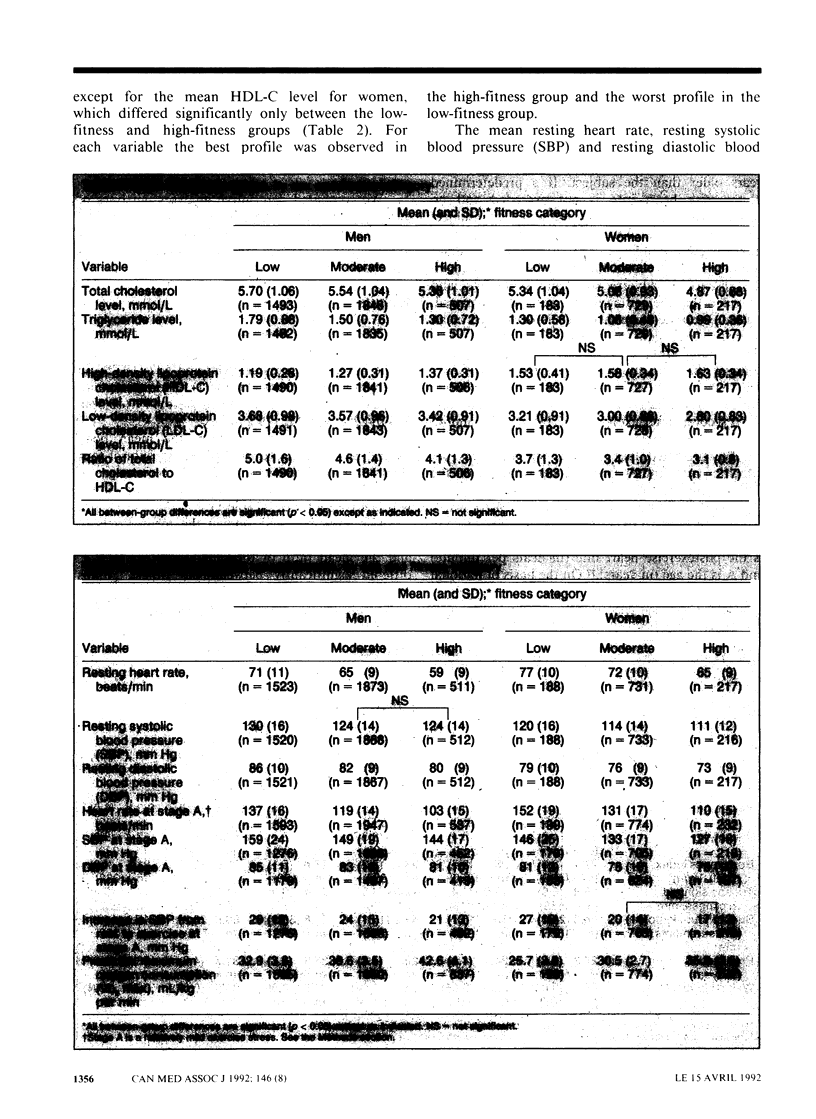
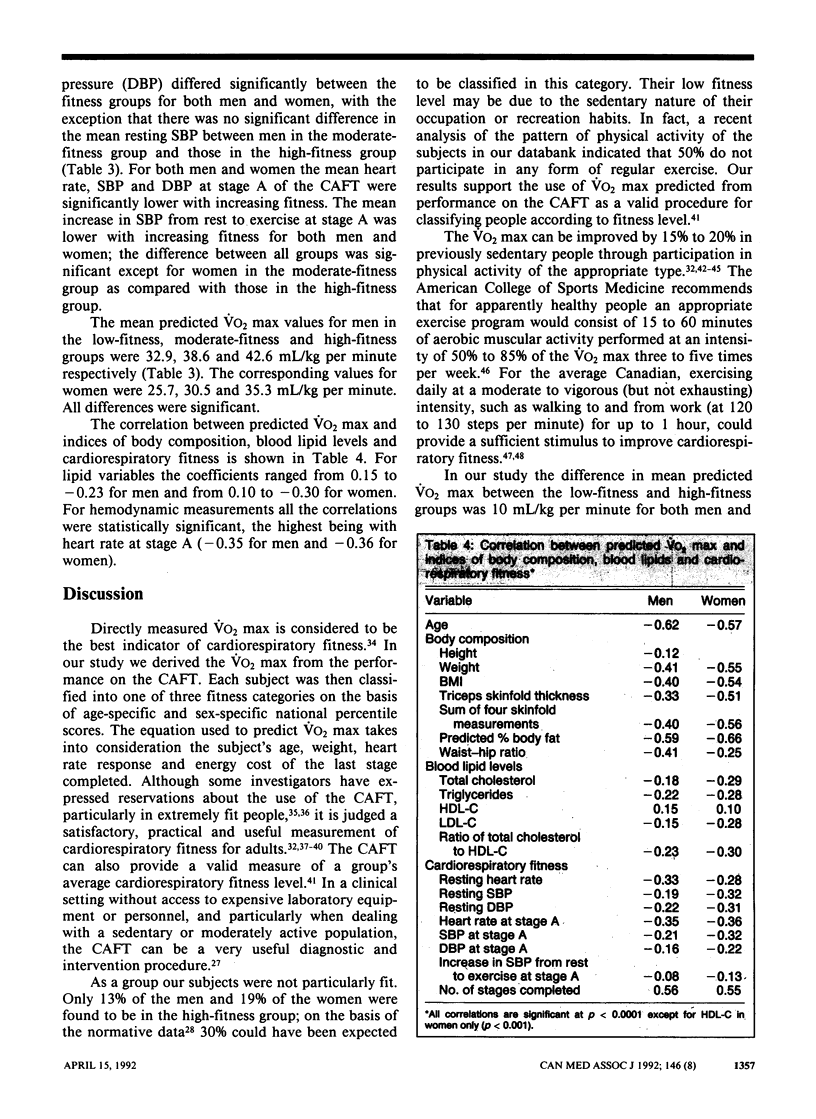
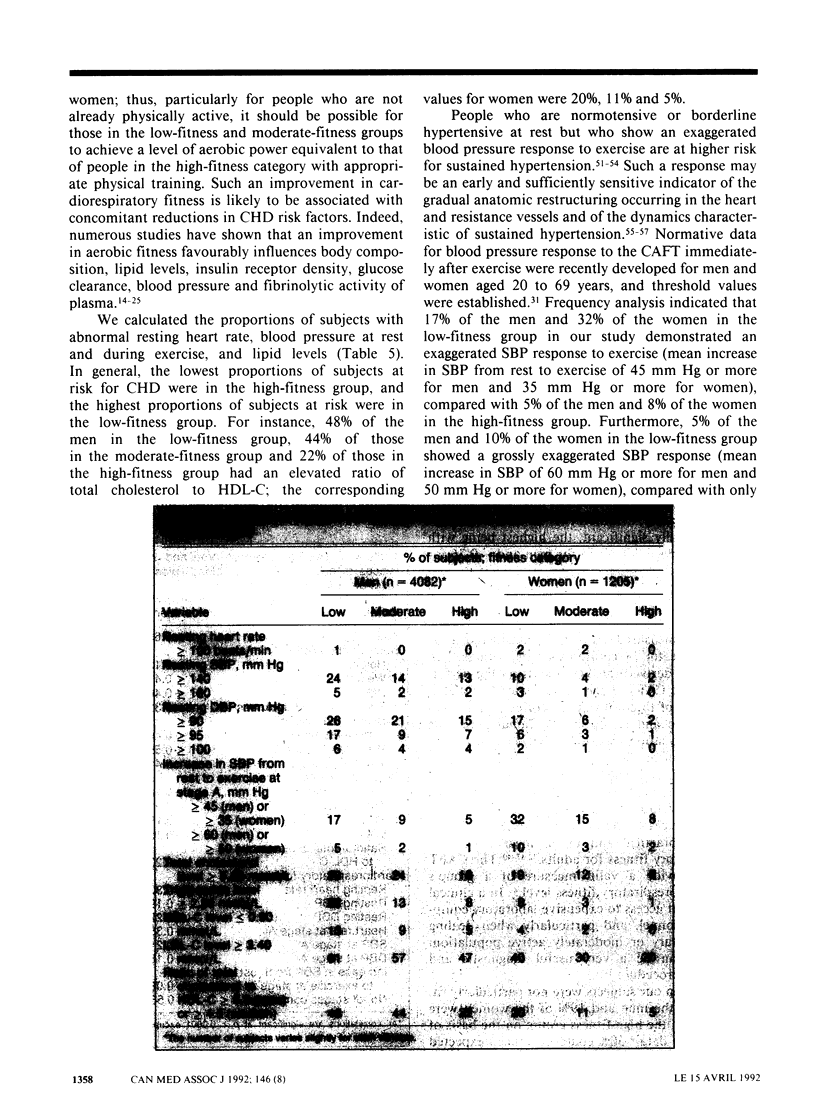
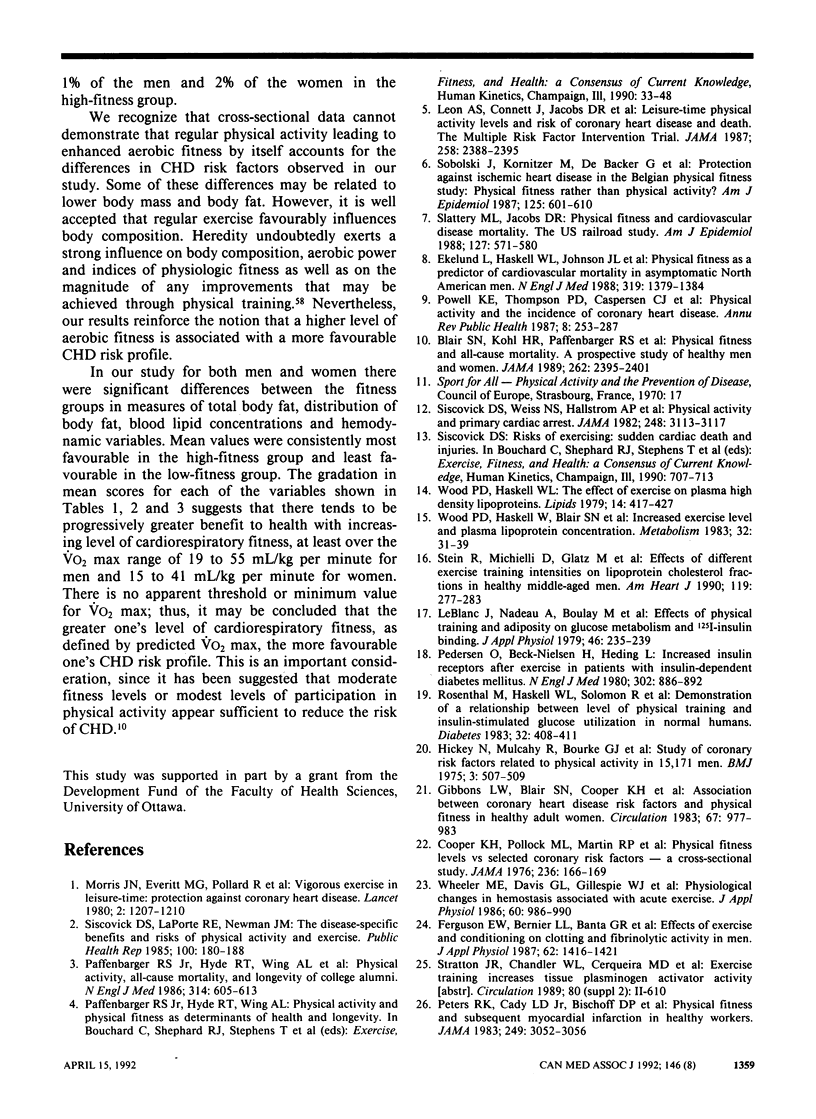
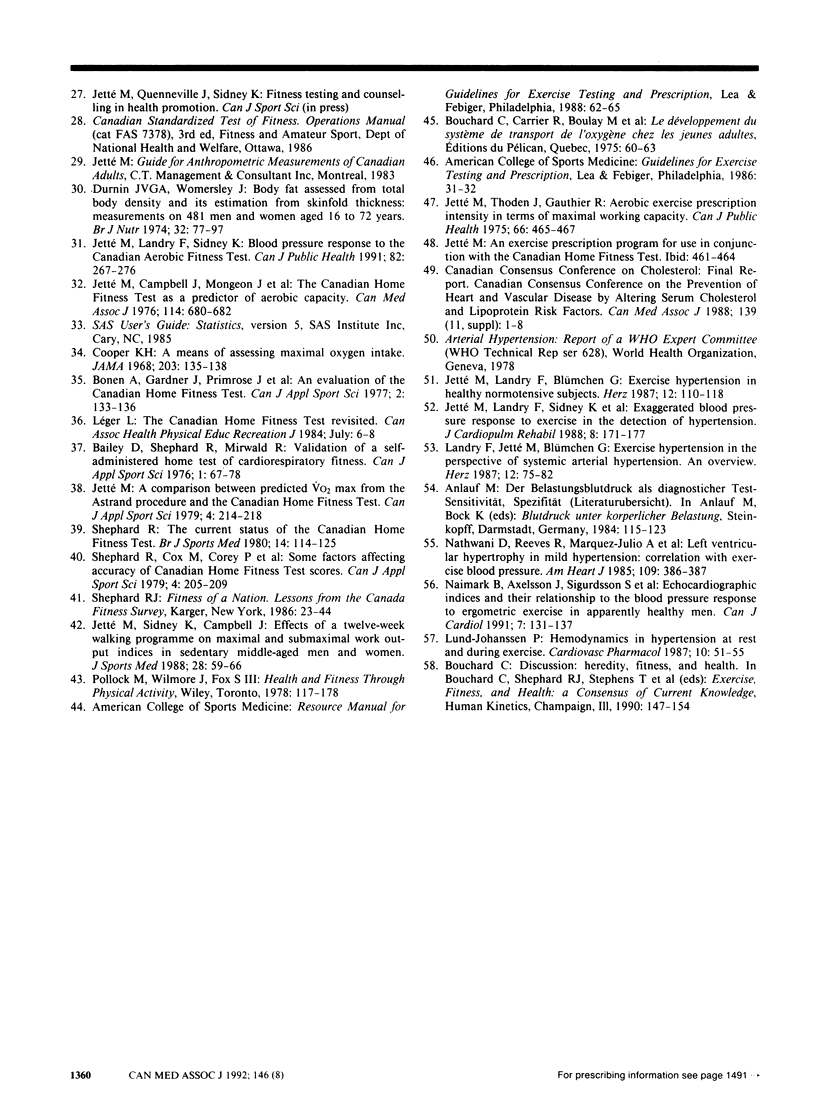
Selected References
These references are in PubMed. This may not be the complete list of references from this article.
- Blair S. N., Kohl H. W., 3rd, Paffenbarger R. S., Jr, Clark D. G., Cooper K. H., Gibbons L. W. Physical fitness and all-cause mortality. A prospective study of healthy men and women. JAMA. 1989 Nov 3;262(17):2395–2401. doi: 10.1001/jama.262.17.2395. [DOI] [PubMed] [Google Scholar]
- Cooper K. H., Pollock M. L., Martin R. P., White S. R., Linnerud A. C., Jackson A. Physical fitness levels vs selected coronary risk factors. A cross-sectional study. JAMA. 1976 Jul 12;236(2):166–169. [PubMed] [Google Scholar]
- Durnin J. V., Womersley J. Body fat assessed from total body density and its estimation from skinfold thickness: measurements on 481 men and women aged from 16 to 72 years. Br J Nutr. 1974 Jul;32(1):77–97. doi: 10.1079/bjn19740060. [DOI] [PubMed] [Google Scholar]
- Ekelund L. G., Haskell W. L., Johnson J. L., Whaley F. S., Criqui M. H., Sheps D. S. Physical fitness as a predictor of cardiovascular mortality in asymptomatic North American men. The Lipid Research Clinics Mortality Follow-up Study. N Engl J Med. 1988 Nov 24;319(21):1379–1384. doi: 10.1056/NEJM198811243192104. [DOI] [PubMed] [Google Scholar]
- Ferguson E. W., Bernier L. L., Banta G. R., Yu-Yahiro J., Schoomaker E. B. Effects of exercise and conditioning on clotting and fibrinolytic activity in men. J Appl Physiol (1985) 1987 Apr;62(4):1416–1421. doi: 10.1152/jappl.1987.62.4.1416. [DOI] [PubMed] [Google Scholar]
- Gibbons L. W., Blair S. N., Cooper K. H., Smith M. Association between coronary heart disease risk factors and physical fitness in healthy adult women. Circulation. 1983 May;67(5):977–983. doi: 10.1161/01.cir.67.5.977. [DOI] [PubMed] [Google Scholar]
- Hickey N., Mulcahy R., Bourke G. J., Graham I., Wilson-Davis K. Study of coronary risk factors related to physical activity in 15 171 men. Br Med J. 1975 Aug 30;3(5982):507–509. doi: 10.1136/bmj.3.5982.507. [DOI] [PMC free article] [PubMed] [Google Scholar]
- Jetté M. A comparison between predicted VO2 max from the Astrand procedure and the Canadian Home Fitness Test. Can J Appl Sport Sci. 1979 Sep;4(3):214–218. [PubMed] [Google Scholar]
- Jetté M., Campbell J., Mongeon J., Routhier R. The Canadian Home Fitness Test as a predictor for aerobic capacity. Can Med Assoc J. 1976 Apr 17;114(8):680–682. [PMC free article] [PubMed] [Google Scholar]
- Jetté M., Landry F., Blümchen G. Exercise hypertension in healthy normotensive subjects. Implications, evaluation and interpretation. Herz. 1987 Apr;12(2):110–118. [PubMed] [Google Scholar]
- Jetté M., Landry F., Sidney K. Blood pressure response to the Canadian Aerobic Fitness Test. Can J Public Health. 1991 Jul-Aug;82(4):267–276. [PubMed] [Google Scholar]
- Jetté M., Sidney K., Campbell J. Effects of a twelve-week walking programme on maximal and submaximal work output indices in sedentary middle-aged men and women. J Sports Med Phys Fitness. 1988 Mar;28(1):59–66. [PubMed] [Google Scholar]
- Jetté M., Thoden J. S., Gauthier R. Aerobic exercise prescription intensity in terms of maximal working capacity. Can J Public Health. 1975 Nov-Dec;66(6):465–467. [PubMed] [Google Scholar]
- Landry F., Jetté M., Blümchen G. Exercise hypertension in the perspective of systemic arterial hypertension. An overview. Herz. 1987 Apr;12(2):75–82. [PubMed] [Google Scholar]
- LeBlanc J., Nadeau A., Boulay M., Rousseau-Migneron S. Effects of physical training and adiposity on glucose metabolism and 125I-insulin binding. J Appl Physiol Respir Environ Exerc Physiol. 1979 Feb;46(2):235–239. doi: 10.1152/jappl.1979.46.2.235. [DOI] [PubMed] [Google Scholar]
- Leon A. S., Connett J., Jacobs D. R., Jr, Rauramaa R. Leisure-time physical activity levels and risk of coronary heart disease and death. The Multiple Risk Factor Intervention Trial. JAMA. 1987 Nov 6;258(17):2388–2395. [PubMed] [Google Scholar]
- Morris J. N., Everitt M. G., Pollard R., Chave S. P., Semmence A. M. Vigorous exercise in leisure-time: protection against coronary heart disease. Lancet. 1980 Dec 6;2(8206):1207–1210. doi: 10.1016/s0140-6736(80)92476-9. [DOI] [PubMed] [Google Scholar]
- Naimark B., Axelsson J., Sigurdsson S. B., Stephens N. L. Echocardiographic indices and their relationship to the blood pressure response to ergometric exercise in apparently healthy men. Can J Cardiol. 1991 Apr;7(3):131–137. [PubMed] [Google Scholar]
- Nathwani D., Reeves R. A., Marquez-Julio A., Leenen F. H. Left ventricular hypertrophy in mild hypertension: correlation with exercise blood pressure. Am Heart J. 1985 Feb;109(2):386–387. doi: 10.1016/0002-8703(85)90622-2. [DOI] [PubMed] [Google Scholar]
- Paffenbarger R. S., Jr, Hyde R. T., Wing A. L., Hsieh C. C. Physical activity, all-cause mortality, and longevity of college alumni. N Engl J Med. 1986 Mar 6;314(10):605–613. doi: 10.1056/NEJM198603063141003. [DOI] [PubMed] [Google Scholar]
- Pedersen O., Beck-Nielsen H., Heding L. Increased insulin receptors after exercise in patients with insulin-dependent diabetes mellitus. N Engl J Med. 1980 Apr 17;302(16):886–892. doi: 10.1056/NEJM198004173021603. [DOI] [PubMed] [Google Scholar]
- Peters R. K., Cady L. D., Jr, Bischoff D. P., Bernstein L., Pike M. C. Physical fitness and subsequent myocardial infarction in healthy workers. JAMA. 1983 Jun 10;249(22):3052–3056. [PubMed] [Google Scholar]
- Powell K. E., Thompson P. D., Caspersen C. J., Kendrick J. S. Physical activity and the incidence of coronary heart disease. Annu Rev Public Health. 1987;8:253–287. doi: 10.1146/annurev.pu.08.050187.001345. [DOI] [PubMed] [Google Scholar]
- Rosenthal M., Haskell W. L., Solomon R., Widstrom A., Reaven G. M. Demonstration of a relationship between level of physical training and insulin-stimulated glucose utilization in normal humans. Diabetes. 1983 May;32(5):408–411. doi: 10.2337/diab.32.5.408. [DOI] [PubMed] [Google Scholar]
- Shephard R. J., Cox M., Corey P., Smyth R. Some factors affecting accuracy of Canadian Home Fitness Test scores. Can J Appl Sport Sci. 1979 Sep;4(3):205–209. [PubMed] [Google Scholar]
- Shephard R. J. The current status of the Canadian home fitness test. Br J Sports Med. 1980 Jul;14(2-3):114–125. doi: 10.1136/bjsm.14.2-3.114. [DOI] [PMC free article] [PubMed] [Google Scholar]
- Siscovick D. S., LaPorte R. E., Newman J. M. The disease-specific benefits and risks of physical activity and exercise. Public Health Rep. 1985 Mar-Apr;100(2):180–188. [PMC free article] [PubMed] [Google Scholar]
- Siscovick D. S., Weiss N. S., Hallstrom A. P., Inui T. S., Peterson D. R. Physical activity and primary cardiac arrest. JAMA. 1982 Dec 17;248(23):3113–3117. [PubMed] [Google Scholar]
- Slattery M. L., Jacobs D. R., Jr Physical fitness and cardiovascular disease mortality. The US Railroad Study. Am J Epidemiol. 1988 Mar;127(3):571–580. doi: 10.1093/oxfordjournals.aje.a114832. [DOI] [PubMed] [Google Scholar]
- Sobolski J., Kornitzer M., De Backer G., Dramaix M., Abramowicz M., Degre S., Denolin H. Protection against ischemic heart disease in the Belgian Physical Fitness Study: physical fitness rather than physical activity? Am J Epidemiol. 1987 Apr;125(4):601–610. doi: 10.1093/oxfordjournals.aje.a114573. [DOI] [PubMed] [Google Scholar]
- Stein R. A., Michielli D. W., Glantz M. D., Sardy H., Cohen A., Goldberg N., Brown C. D. Effects of different exercise training intensities on lipoprotein cholesterol fractions in healthy middle-aged men. Am Heart J. 1990 Feb;119(2 Pt 1):277–283. doi: 10.1016/s0002-8703(05)80017-1. [DOI] [PubMed] [Google Scholar]
- Wheeler M. E., Davis G. L., Gillespie W. J., Bern M. M. Physiological changes in hemostasis associated with acute exercise. J Appl Physiol (1985) 1986 Mar;60(3):986–990. doi: 10.1152/jappl.1986.60.3.986. [DOI] [PubMed] [Google Scholar]
- Wood P. D., Haskell W. L., Blair S. N., Williams P. T., Krauss R. M., Lindgren F. T., Albers J. J., Ho P. H., Farquhar J. W. Increased exercise level and plasma lipoprotein concentrations: a one-year, randomized, controlled study in sedentary, middle-aged men. Metabolism. 1983 Jan;32(1):31–39. doi: 10.1016/0026-0495(83)90152-x. [DOI] [PubMed] [Google Scholar]
- Wood P. D., Haskell W. L. The effect of exercise on plasma high density lipoproteins. Lipids. 1979 Apr;14(4):417–427. doi: 10.1007/BF02533428. [DOI] [PubMed] [Google Scholar]


